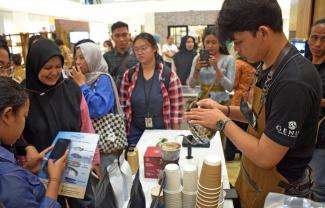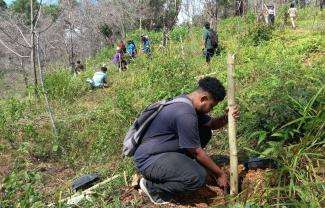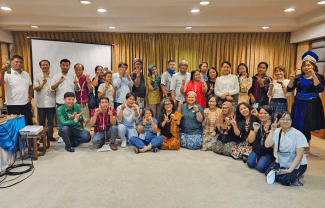Brgy. San Jose in the municipality of Coron is one of the areas provided assistance with the Early Recovery - Livelihood Assistance Project supported by WJR. Samdhana's local partner is the Indigenous Peoples Organization (IPO) - Samahan ng Katutubong Tagbanua ng San Jose (SAMASAN). It was organized, primarily to advance Indigenous Peoples rights and welfare and assert collective ownership of ancestral lands and waters. San Jose is one of the barangays in Coron that is majorly populated by the Calamian Tagbanua. Their ancestral domain claim covers both the barangays of San Jose and Decalachao; the claim is still ongoing processing.
The CBMS 2011-2013 survey showed that 53% or 124 households, out of 232 were below the poverty threshold. Household heads are mainly fishermen; while some are engaged in seaweed faming. Other livelihood activities are gathering of shells and other sea products, mostly for consumption and seldom sold for the market. Other families are engaged in rice farming during the rainy season, when the paddies are irrigated. Only very few families are into vegetable farming and backyard animal raising. Some are hired into resorts and others occasionally find jobs in tourism related activities.
STY Haiyan had a great impact in Brgy. San Jose. The Municipal Disaster Risk Reduction Office reported that about 100 houses were totally damaged, while another 150 houses had partial damage; agricultural damage across the barangay was pegged at 90%. Many families reported losses and damages to their boats and animals. As the last barangay of Coron, bordering with Brgy. Cheey, Municipality of Culion, San Jose was one of the last areas that were given assistance. Some received food relief and assistance for house repairs and shelters and livelihood asset from Social Action Center, Cordaid (core shelter), FAO (fishing gears and seaweeds) and Department of Agriculture (rice seeds). Samdhana has provided livelihood recovery assistance through the support of WJR under the small grant.
Gains from the Livelihood Asset Recovery Project under the Indigenous Peoples Support Fund (IPSF)
There are 53 direct household beneficiaries in Brgy. San Jose which received livelihood assistance from WJR, while around 69 families are expected to indirectly benefit from the ‘Bigasang Bayan' which SAMASAN operates, from their community start-up fund. The livelihood assistance was given in the form of a small grant to SAMASAN, which enables the IPO to manage and implement directly their own project for the first time. Fishnets and its accessories were distributed to 25 families/HH, while 28 families/HH received piglets for their backyard animal raising activities. Beneficiaries were identified by SAMASAN and were finalized after going through several consultations and meetings to meet the beneficiary criteria set by the association themselves. Since the fishnet distribution in May 2014, some of the families like Danilo and Raquel Alvarez, have improved their fish catch, using the materials given to them.
Pains and Challenges
A Project Management Team was formed from the SAMASAN Officers, to focus on the Bigasang Bayan project. A series of meetings were done to clarify the mechanism of the Bigasang Bayan. However the Project Management Team was not able to take off as expected. Delegation of responsibilities from the part of the IPO Chair and Treasurer for the project implementation is not visible. On the contrary, they took all project related matters in their own hands. We have observed that there is lack of sound finance policy and procedure, albeit recording of transactions improved significantly. Money intended for Bigasang Bayan was used for other purposes, hence, at present, it has not started yet. The Samdhana team facilitated a general assembly meeting with SAMASAN to discuss these issues with the officers and the members. As a result of the meeting, a review team was created to look into the list of target beneficiaries, and an audit team was created to check the financial transactions and record of the treasurer. It was agreed as well that the officers who loaned the start-up funds intended for the Bigasang Bayan will return the amount, so that they will be able to proceed with the project. Samdhana also reached out to the Vice Chairperson of SAMASAN who had been very uncooperative from the beginning of the partnership.
Participatory Vulnerabilities and Capacities Assessment (PVCA) Towards Preparing Communities and Reducing Risks in the Face of Climate Change
In order to bring the affected communities one step forward in their recovery towards better preparedness for other disasters or inevitabilities in the future, the capacity-building for community preparedness and disaster risk reduction (DRR) is also being undertaken by Samdhana. WJR is supporting the capacity-building on PVCA and DRR for the six areas that have been identified.
The Participatory Vulnerabilities and Capacities Assessment or PVCA is the first stage for enhancing community preparedness in the face of increasing natural calamities or disasters and worsening impacts of climate change. The PVCA intends to introduce various tools that will surface the vulnerabilities and risks of the community, as well as its assets and resources that will enable them to address the risks. The information that will be gathered from the PVCA can be used by SAMASAN and by the Barangay Local Government Unit that will then feed into planning activities, and can inform other planning processes at the municipal level. The focus of Samdhana is to assist the community partners in conducting their own PVC assessment, so that this will inform the Ancestral Domain Sustainable Development and Protection Plan (ADSDPP) and integrate DRR as well as climate change adaptation (DRR-CCA) into the community's plans.
The first skills training focused on providing the basic concepts of climate change, its threats on the ancestral domain and on the indigenous peoples, basic concepts of disaster risk reduction and climate change adaptation. Since these are big and foreign words to the tribespeople, care was given to simplify the concepts and seek out the equivalent terms in Tagbanua dialect. The skills training intended to create a team of local PVCA Facilitators who will organize and facilitate the actual assessment activities within their own communities.
In the first training for PVCA Facilitators conducted last April 27-29, 2015, seven members of SAMASAN attended. Out of the seven SAMASAN participants, three were women and two were BLGU representatives, who were at the same time Association members. After completing the training, they are now able to facilitate and organize the conduct of the assessment activities in San Jose. They are the first team to conduct the PVCA. The Facilitators team called for their community action planning to schedule the various activities they need to do. They also sought the support and cooperation of the Barangay LGU and those of their members.
Mapping activities and the community planning for conduct of the PVCA. Photo by Shane C.Naguit for Samdhana.
As of this report, Brgy. San Jose and SAMASAN have already conducted three mapping activities and have produced the following: community hazard map identifying the hazardous areas and potential disaster risks, livelihood and resource map identifying both the livelihoods of women and men, and vulnerable sector map that plots out the houses of the population belonging to the senior citizens, persons with disabilities, teenage parents or couples, and single-headed/ female-headed households. Information was collected from interviews with the Mamepet or the Elders and traditional leaders, and the maps were validated through a transect walk, and a transect boat ride around the island to cover their ancestral waters. SAMASAN Facilitators team is now preparing to do the seasonal calendar for their farming and sea-based livelihoods. Other assessments that will still be conducted will be through the following tools: problem tree and network analysis.
At left, the San Jose PVCA Facilitators with members of the community during the survey. At right, Chairman Villoga at the back and Tatay Ivan Cresencio doing the transect boat ride to include ancestral waters in the map. Photo by Shane C. Naguit for Samdhana
From the PVCA and data-gathering activities, data processing will be done in preparation for a joint analysis with the community, and data validation. After this will be the community planning for emergency preparedness and disaster risk reduction and management. Samdhana team and SAMASAN are looking forward to close collaboration with the LGU throughout all this process, and that the LGU will also be able to counterpart for the expenses in completing the process. If the community plans will be adopted by the Sangguniang Council and the BLGU, then this will comprise the barangay's DRRM Plan (BDRRMP) and will be funded under the mandatory DRR budget provided for the LGU.
However, in terms of the timeline, SAMASAN is expecting that the whole process may go up all the way to December, because of practical considerations. All of the PVCA Facilitators are volunteers receiving only minimum honorarium, and while committed to the process, they need time for their daily income and livelihoods. Community members need to participate in the PVCA activities, and they are only able to schedule certain days in a week to participate in the activities. Conduct of each PVCA tool takes a minimum of one day or as long as three straight days, which is considerable time for community members to take out from their day to day earning of income. However, the return on ensuring the full and proper participation of the community members, as well as collaboration with the BLGU is that the BDRRM Plan will have undergone a genuine participatory process, and will have high ownership of the community, which in turn provides a high assurance that when the plans are implemented, they are appropriate and doable for the community.
Women participation in SAMASAN is very visible in the affairs of the association. They become more active in meetings and other activities, and have contributed significantly during discussions. They are among those who clarify issues besetting the association - beneficiary identification, finance disbursement and systems and were very vocal in asking for reforms. Samdhana has also attempted to introduce the discussion on gender and equality concerns by conducting the Rapid Care Assessment tool, for the women to be aware of the broad range or responsibilities they undertake and the contribution that they bring into their families in terms of care work, which is usually un-valued, and economic or cash contribution.
Recommendations
In the short period that Samdhana has embarked on the partnership with SAMASAN and has accompanied it, we have come up with several recommendations that will assist in strengthening the organization, which are the following:
- Review, amendment and approval of organizational charter or Constitution and By-Laws vis-Ã -vis revisiting of and documentation of the traditional governance system
- Redefine roles, responsibilities of leaders and members
- In the continuing work of Samdhana assisting Indigenous organizations to strengthen their Indigenous governance, the above recommendations can feed into the designing of an Indigenous leadership development course.






